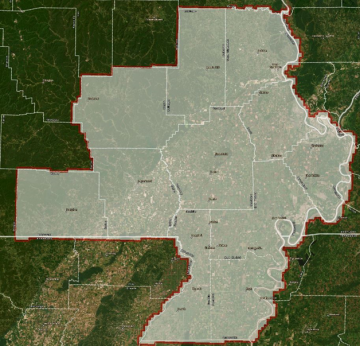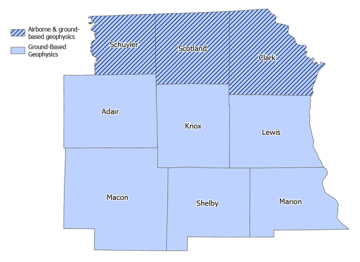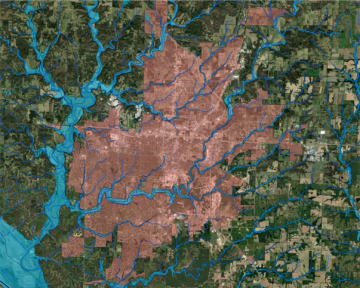
The MoHIC Mission
Missouri experienced historic floods in recent decades, most notably the floods of 1993, 1998, 2011, and 2019. The 2019 flood caused an estimated $20 billion in losses impacting the Missouri and Mississippi River basins. The duration of this flooding also surpassed that of 1993, with locations on the Missouri River in declared flood state for 279 days and on the Mississippi River for close to 100 days.
The impacts of the 2019 flooding demonstrated the need for better flood protection and flood resiliency in Missouri. In response, Governor Mike Parson established the Flood Recovery Advisory Working Group, which recommended the formation of a water center for the State of Missouri. In 2022, Missouri Department of Natural Resources received funds from the American Recovery Plan Act (ARPA) to develop the Missouri Hydrology Information Center (MoHIC). The MoHIC team and its partners are dedicated to serving Missouri citizens during both flood and drought by providing accessible user-friendly information through an online dashboard now in development.
Users of the MoHIC dashboard will find information and resources on MoDNR’s streamgage network, soil monitoring and mapping, statewide flood inundation mapping (FIM), imagery and Light Detection and Ranging (LiDAR), and northeast Missouri aquifer supply mapping.
Additional Information
- Drought
- Drought Assessment Committee
- Flooding
- Flood Recovery Advisory Working Group
- Missouri Streamgage Network
- Soil Monitoring and Mapping
Soil moisture and temperature greatly affect the physical, chemical, and biological processes in the soil and resident vegetation. Soil moisture information helps in understanding the potential for the storage and movement of water within the soil profile. Soil moisture content at the time of a rain event strongly influences if the precipitation will infiltrate into the soil or run off the surface. Soil temperature is also important for monitoring the potential for runoff when surface soil is frozen. Additionally, soil temperature impacts plant growth and soil microbial activity.

The need for more real-time soil data is called for in the 2020 Missouri Water Resources Plan and the 2023 Missouri Drought Mitigation and Response Plan. Information from a statewide monitoring network will assist with drought and flood forecasting, agricultural needs, water supply monitoring, forest fire prediction and other natural resource activities.
The department’s Soil Monitoring Initiative is comprised of two distinct projects: the Soil and Atmospheric Monitoring project, which aims to expand soil moisture and temperature monitoring across the state, and the Soil Moisture Mapping project, which will develop statewide, gridded soil maps using monitoring station data.
The Soil and Atmospheric Monitoring project will expand statewide long-term soil monitoring by installing in situ soil sensors alongside groundwater observation wells and weather stations. To help soil data be more meaningful, most of the monitoring stations will also measure atmospheric variables, such as air temperature, wind speed and direction, relative humidity, solar radiation, and precipitation. While not every weather station across the state is suitable for soil monitoring, the project will strive to have every soil monitoring site function as a ‘total water station’ by also collecting the standard suite of atmospheric variables. The statewide soil monitoring network will consist of stations operated by various state and federal entities.
The Soil Moisture Mapping project will develop gridded, statewide soil moisture and temperature maps using the data collected from each monitoring station. The mapping methodology will likely combine station data and modeling to interpolate soil moisture content, plant available water, and soil temperature at several depths.
Since 2020, soil sensors have been placed at several of the groundwater-level monitoring stations maintained by the department’s Water Resources Center. At each station, five probes were placed in the ground at depths of 2, 4, 8, 20 and 40 inches. Soil moisture and temperature data are collected every 30 minutes and transmitted every hour via satellite. The department is currently conducting soil monitoring in the following counties: Atchison, Barry, Barton, Benton, Buchanan, Callaway, Cape Girardeau, Chariton, Christian, Daviess, Jackson, Jefferson, Laclede, Newton, Pemiscot, Perry, Pettis, Ripley, Saline, Scotland, St Louis, and Warren.
Soil moisture and groundwater-level data, along with precipitation data (where available) are available online in near real-time to the public. Soil monitoring locations can be found on the department’s Groundwater Observation Wells map by filtering to see only the sites with soil moisture data.
- Imagery and LiDAR

Imagery is critically important for understanding what is on the ground, whether that's large-scale images of forests, bare ground images across farmlands, or scanning the surface of the Earth for elevation models. Two types of imagery will be collected and/or updated through the Missouri Hydrology Information Center (MoHIC): leaf-off imagery and LiDAR. Having current, up-to-date imagery of both is critical to providing accurate information.
Leaf-off imagery consists of aerial images taken in the fall or winter when the leaves of trees are off to see clearly to the ground. The features captured in this imagery informs watershed conditions, runoff, moisture retention and modeling. LiDAR is a remote-sensing technology that uses laser pulses to measure surfaces and objects in three dimensions to create 3D elevation models. Leaf-off imagery and LiDAR are both used in a multitude of different applications, varying from watershed modeling to wetland delineations. Data like leaf-off imagery and LiDAR is also free for the public at the Missouri Spatial Data Information Service (MSDIS).
In 2023, MoHIC supported the acquisition of new leaf-off, six-inch resolution for northern Missouri. The final product can be accessed online at MSDIS. That same year MoHIC also applied to the United States Geological Survey’s (USGS) 3D Elevation Program (3DEP) Data Collection Announcement (DCA) to cost share the collection of new LiDAR. The application was granted a 25% Federal cost share on the 7,314 square mile project. The new LiDAR will be collected at a Quality Level 1, replacing the older Quality Level 2 LiDAR. The imagery was collected in Spring 2024 and will be available to the public in 2027.
- Northeast Missouri Aquifer Characterization Project

Aquifer characterization is an important duty of the Groundwater Section of the Water Resources Center. Northern Missouri relies heavily on surface water resources due to poor groundwater quality in bedrock aquifers. Higher drought susceptibility in Northern Missouri has and still necessitates the exploration of additional groundwater aquifers to ensure safe and secure water supplies.
Unconsolidated surficial materials above bedrock can be aquifers and are promising targets for groundwater resources.
The Northeast Missouri Aquifer Characterization Project is focused on discovering and describing unknown but suspected shallow buried channel aquifers in an area of poor groundwater quality and surface water reliance. The project will cover nine counties in Northeast Missouri: Clark, Scotland, Schuyler, Lewis, Knox, Adair, Marion, Shelby, and Macon. The approach to this project includes three phases: calibration, measurement and prediction, and validation. The project will deploy three technologies to collect data to complement existing data in the region. Each technology provides different types of data at different resolutions both vertically and horizontally, and consequently have different coverage areas.One technology deployed will be the ground-based geophysical method Horizontal to Vertical Spectral Ratio (HVSR), a type of passive seismic. This will provide depth to bedrock information without the need to drill at each location. However, such a geophysical method requires calibration, and so, will be complimented by a second technology, drilling. A limited number of test holes will be drilled proximal to HVSR sites to properly calibrate velocity models of local unconsolidated materials for accurate depth to bedrock measurements from HVSR. In addition to ground-based geophysical methods (which rely on impedance, or acoustics), an Airborne Electromagnetic (AEM) survey is proposed to augment a portion of the study area with resistivity volumes. Resistivity volumes are a great way to interrogate the subsurface, especially with respect to water resources, as water-rich formations and even saline vs freshwater character can be interpreted from such geophysical volumes. Test holes give us physical constraint on bedrock depth at specific locations, HVSR can use those physical depths to calibrate and measure depths away from test holes to identify probable areas for buried channel aquifers, and AEM provides aquifer characteristics of identified channels. Test hole data will be used for calibration and validation, and the data derived from geophysical methods will be used to predict the presence of channels.
- Flood Modeling

The Missouri Hydrology Information Center (MoHIC) strives to improve flood planning and flood resiliency within Missouri by delivering a statewide flood model that will aid in the protection of property and lives during flooding events. A flood model generally consists of hydraulic, hydrologic, and meteorological models used to forecast impacts on streams. These forecasts predict flooding, and flood models track flooding as it occurs across an area of interest. MoHIC is dedicated to providing a flood model that serves both citizens and emergency responders within Missouri.
A national initiative by the Office of Water Prediction (OWP) within the National Oceanic and Atmospheric Administration (NOAA) has taken the forefront of predictive and real-time flood inundation modeling and mapping across the country. This national initiative known as the National Water Model Flood Inundation Mapping service (NWM FIM) will be available as a public service for Missourians in the fall of 2024. MoHIC will display the NWM FIM service for Missouri on the MoHIC dashboard. Citizens and emergency responders will be able to view predicted flood waters at the street scale up to four days before a storm and hourly updates of flood waters during actual storm events.
MoHIC is currently involved in collaborative efforts with other various state and federal agencies in developing ways to enhance NWM FIM for Missouri and will continue to update the NWM FIM service on the MoHIC dashboard per the OWP and NOAA’s timeline.

